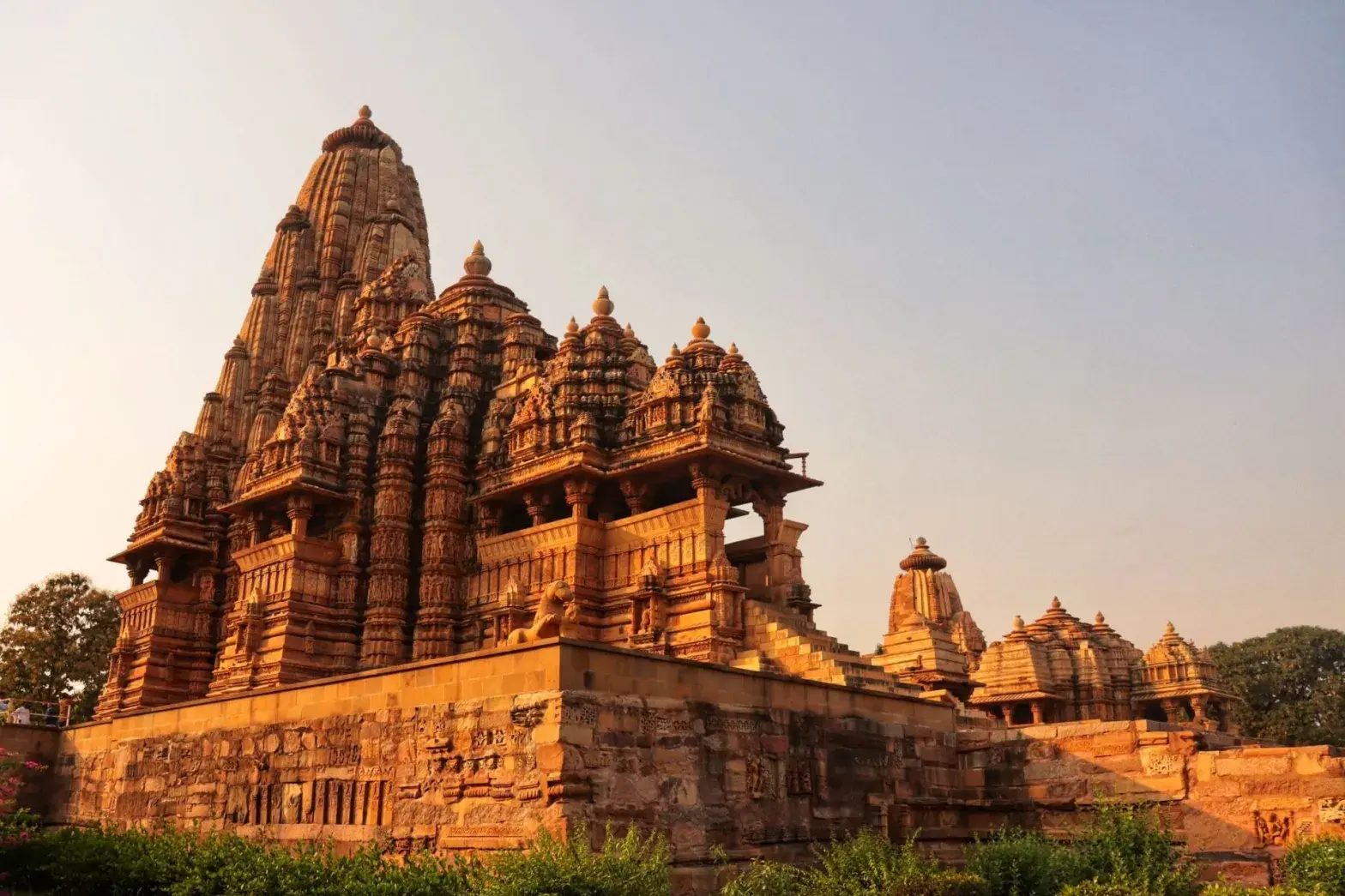
Khajuraho
That is Khajuraho for you. Located in Madhya Pradesh, it is a world-famous UNESCO World Heritage site that attracts thousands of visitors every month. In reality, Khajuraho is just a small village located at the foothills of the beautiful Vindhya Range of mountains, but its picturesque rock carvings have made it one of the must-see places in India. It has about 85 temples, each devoted to a different art, and they are clustered in different locations. Being a place of international importance, Khajuraho is well connected by road, train, and air.
For those of you coming to the city to see its marvels, don’t forget to check these places:
Kandariya Mahadev: Among all the temples in Khajuraho, this is the biggest and most well-preserved temple. It was built by the revered Chandela King Dhangadeva in the year 1030. The village was then the religious capital of the region and thrived on the ancient beliefs of Hindu scriptures and Vedas. The temple is dedicated to Lord Shiva and features some of the most erotic carvings that Khajuraho has. Kandariya Mahadev temple is best visited during the sunrise when tourists are fewer creating an opportunity for stunning photographing of this archaeological wonder. The entry cost is 10 rupees for Indians and 250 rupees for foreigners. The temple opens from 5:00 a.m. to 12:00 noon and 4:00 p.m. to 9:00 p.m. on all days.
Lakshmana Temple: Like most temples of Khajuraho that are on the UNESCO World Heritage list, Lakshmana Temple is no exception. With its astute craftsmanship and meticulous construction, the temple’s architecture is very symmetric and pleasing to the eye. Its floor is covered with beautiful Panna marbles and complements the detailing of the scriptures. The Lakshmana Temple also has a light and sound show every evening, which is a great attraction for all. The entry cost is 10 rupees for Indians and 250 rupees for foreigners. The temple opens from 5:00 a.m. to 12:00 noon and 4:00 p.m. to 9:00 p.m. on all days.
Devi Jagdamba Temple: Located within walking distance of the Kandariya Temple, the Devi Jagdamba Temple is a beautiful complex to remember. Most people who come here spend more time at the Kandariya Temple, missing the loveliness of Devi Jagdamba Temple.
Chaturbhuj Temple: An example of exceptional stone artwork, the Chaturbhuj Temple is unique among all. It falls under the southern group of temples and is located near the airport. The temple is dedicated to Lord Vishnu, and aside from its amazing architecture, it offers a great place to watch sunsets and capture wide views of the Orcha Fort. There is no entry fee. The temple opens from 5:00 a.m. to 12:00 noon and 4:00 p.m. to 9:00 p.m. on all days.
Dulhadev Temple: Part of the southern group of Khajuraho Temples, Dulhadev Temple features beautiful stone carvings of Lord Shiva and Goddess Parvati on its walls. The interior of the temple has a huge Shiva linga that has remained untouched by renovations since it was made. The temple is slightly off the usual routes of the other temples, and not many people visit it, making it a quiet spot where you can appreciate the beauty of ancient Hinduism in all its glory.
Panna National Park: Panna is famous for its marbles and beautiful scenery. Of all the national parks in India, Panna is where you are most likely to spot a lion. Or, if it's abundant natural resources you're after, visit Panna after the monsoons. It has a picturesque forest, and its raw appeal encourages adventure seekers to explore it throughout the year. The national park authority runs regular safaris that offer stunning views. Often, in addition to spotting a lion or a tiger, visitors observe many other kinds of wild animals and birds.
Beni Sagar Dam: Located about 12 km from Khajuraho's center, Beni Sagar Dam offers a well-deserved break from the temple sites. Though it’s still raw and doesn’t offer much to see except a few buffaloes taking a bath, a quick walk here is enjoyable. It’s a quiet place with not much activity around. Beni Sagar Dam falls on the way to Rajgarh Fort and can be a good place to enjoy a peaceful lunch or dinner.
Parsvanath Temple: The eastern side of Khajuraho is home to Jain temples. The layout and structural design of Parsvanath Temple are similar to its western counterparts, but this side gets relatively fewer tourists. It was dedicated to the first Tirthankara and features a sanctum and a maha mandapa inside the complex. The rock carvings on the walls represent Agni, Shiva, Kama, Rati, and Shri Lakshmi Narayana. You can hire an auto or rent a bike if you’re interested in exploring the city at your own pace. The temple is easy to reach and well-maintained. There is no entry fee.
Viswanath Temple: Similar to the Kandariya Mahadev Temple in layout and design, the Viswanath Temple complex is in front of the Nandi Temple. It includes an entrance veranda, a huge study chamber, mandapa, maha-mandapa, and a great entrance hall. The external walls of the temple feature impressive carvings, making it a great backdrop for photography.
State Museum of Tribal and Folk Art: A perfect place for history buffs to experience the magical past of India’s great kings and their dynasties. The museum has a collection of masterpieces (woodworks, paintings, and scriptures) representing the rich culture and heritage. A glimpse of these rare artifacts takes you through the customs and traditions of the tribal people of Madhya Pradesh. The museum is located within walking distance of the western group of temples.
Archaeological Museum: It can be visited free with the temple ticket, so hang on to it. The museum has plenty of relics that act as a center of culture for visitors. Though its initial aim was to collect art objects of historical and artistic significance and display, protect, and preserve them for visitors to learn about the past culture, it is struggling to maintain its vision. The museum desperately needs a makeover and requires experts who can disseminate facts and information to give a glimpse of India’s history to tourists.
Interested in visiting Khajuraho? Just Click Here And Plan Your Vacation.
